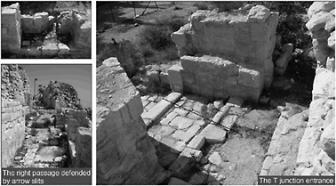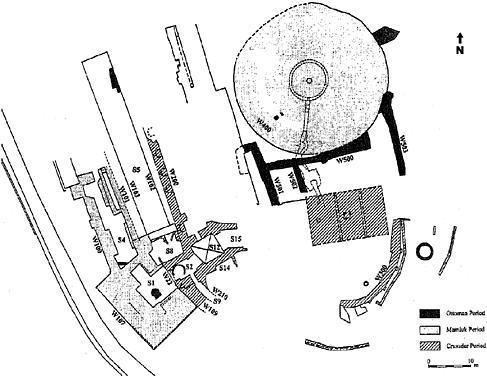Muslim Fortresses in the Levant: Between Crusaders and Mongols (89 page)
Read Muslim Fortresses in the Levant: Between Crusaders and Mongols Online
Authors: Kate Raphael
Tags: #Arts & Photography, #Architecture, #Buildings, #History, #Middle East, #Egypt, #Politics & Social Sciences, #Social Sciences, #Human Geography, #Building Types & Styles, #World, #Medieval, #Humanities

The main gate and the secret passage
Ibn Shaddād describes the Mamluk gate complex. He begins with the wooden drawbridge stretched across the outer moat and operated by a simple pedal (
dawāsa
, ). Once across, one came to a T-shaped junction with a gate on the right and another on the left. This structure has no close parallel among Ayyubid or Frankish fortresses, which followed the traditional and conservative structure of bent gates and gate-towers.
). Once across, one came to a T-shaped junction with a gate on the right and another on the left. This structure has no close parallel among Ayyubid or Frankish fortresses, which followed the traditional and conservative structure of bent gates and gate-towers.
112
A large Mamluk gate complex was uncovered in the southwest corner during the excavations conducted in 1995 (Figures
4.15
,
4.16
). This is not the gate described by Ibn Shaddād, but it was built along similar lines. It served as an entrance to the inner bailey. Certain sections of the previous Frankish structure were incorporated in this new gate.
The quality of both masonry and construction is rather poor. The local Safad limestone is soft and porous and of a lower quality than that further north in the vicinity of . This, however, is not an adequate reason for the generally low standard of the work. The dating of the gate to the Mamluk period relies on the design of the arrow slits along the passage and the fact that Mamluk coins were found in the foundation levels. It is possible that the building material was simply recycled and taken from the Frankish structures that were demolished during the siege. Since the gate was not located on the external curtain wall it was not expected to withstand heavy attack, thus the quality of the work was of no great importance.
. This, however, is not an adequate reason for the generally low standard of the work. The dating of the gate to the Mamluk period relies on the design of the arrow slits along the passage and the fact that Mamluk coins were found in the foundation levels. It is possible that the building material was simply recycled and taken from the Frankish structures that were demolished during the siege. Since the gate was not located on the external curtain wall it was not expected to withstand heavy attack, thus the quality of the work was of no great importance.
Ibn is the only Arabic source that describes the building of the secret passage by the Mamluks (Maqrīzī quotes him almost word for word).
is the only Arabic source that describes the building of the secret passage by the Mamluks (Maqrīzī quotes him almost word for word).
113
Secret passages existed prior to the Mamluk conquest of the fortress and they are briefly mentioned by the anonymous French chronicler as “underground tunnels between the outer wall and the [inner] ditch.”
114
Pringle suggested that the secret passage attributed by the chroniclers to Baybars was originally built by the Templars.
115
As there is no archaeological evidence all we have in this case is the written word. Hartal’s thorough examination of the secret passage at shows the Mamluks were sufficiently aware of the importance of such passages, and equally capable of building them whether long or short, above or below ground.
shows the Mamluks were sufficiently aware of the importance of such passages, and equally capable of building them whether long or short, above or below ground.
116
A free-standing central tower
With the help of the archaeological remains and of the sources it is possible to get a reasonably accurate picture of what this free-standing tower of outstanding height looked like (
Figure 4.17
). It suggests some new ideas in the field of military architecture that may be ascribed to the Mamluks, although once introduced at Safad they were not repeated elsewhere.
The great round tower is mentioned by Ibn Shaddād, Dimashqī and . Though today it is largely in ruins, this immense structure that probably served as a keep, still dominates the summit. One of its most unusual features is its complete isolation; the tower is a free-standing structure. It was not incorporated in the inner
. Though today it is largely in ruins, this immense structure that probably served as a keep, still dominates the summit. One of its most unusual features is its complete isolation; the tower is a free-standing structure. It was not incorporated in the inner

Figure 4.15
Safad, the remains of the Mamluk inner gate on the southwest

Figure 4.16
Safad, plan of round central tower and Mamluk inner gate
curtain walls nor did it form part of a chain of towers. The walls that can still be seen surrounding it date to the Ottoman period. The idea of a huge fee-standing tower within a fortress is rare in both Frankish and Muslim fortifications. The best Frankish examples are Chastel Blanc (Safita) and Gibelet (Jubayl) dating to the twelfth and early thirteenth centuries.
Al-Safadī writes: “He built in the fortress a huge tower that was very tall and rose to the height of eighty , and its building was completed in the reign of
, and its building was completed in the reign of [Qalāwūn].”
[Qalāwūn].”
117
The diameter, according to al-Dimashqī, was 40.6m.
118
The sources are not unanimous concerning the height, giving it as between 46 and 96.6m. Ibn Shaddād estimates it was one hundred high (58m), and says that from the top one could see whoever walked along the moat or around the fortress.
high (58m), and says that from the top one could see whoever walked along the moat or around the fortress.
119
The Mamluks did not take into account the tectonic activity of the region; the tower partly survived into the late Ottoman period, though a series of earthquakes in 1759 and again in 1837 submitted this massive construction to pressures it may not have been designed to withstand. What remains today is the main entrance and the cistern carved out of the bedrock below it. The entrance is encased in a solid stone structure that served as the tower’s base (
Figure 4.17
). The rest of the tower can be reconstructed from the information provided by the sources. Dimashqī’s account describes two winding passages each wide enough to enable five horses to climb to the top. replaces the five horses with two camels.
replaces the five horses with two camels.
120
This path was designed in the shape of a snail shell , a wide spiral ramp or staircase encased in the walls and leading to the flat rooftop (
, a wide spiral ramp or staircase encased in the walls and leading to the flat rooftop (
Figure 4.18
). The latrines , which are mentioned by al-Dimashqī, can still be seen at the entrance. There was no shortage of storage place and the water in the large cistern could supply the whole garrison and the community of the nearby area.
, which are mentioned by al-Dimashqī, can still be seen at the entrance. There was no shortage of storage place and the water in the large cistern could supply the whole garrison and the community of the nearby area.
121
The bell-shaped cistern held approximately 800 cubic meters of water.
